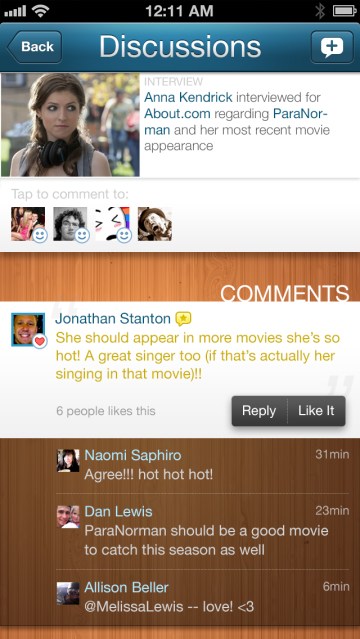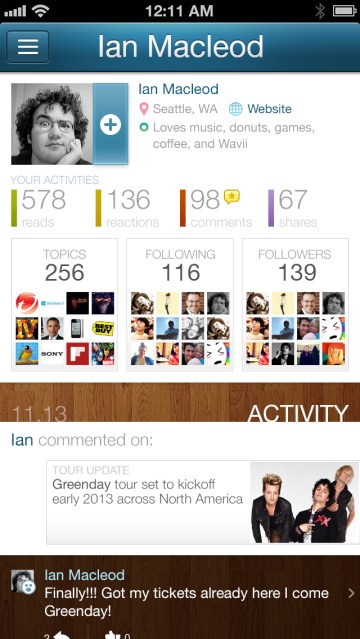Seattle-based Wavii, the news aggregation startup that finally launched into public beta this April after years of stealth mode, is today unveiling an entirely new product with today’s debut of Wavii 2.0 for iPhone. The app has been completely rebuilt from the ground-up, and now introduces a number of new and improved elements, including better news feeds, social interactions, an improved sign-up process, and more.
Wavii, for those unfamiliar, uses machine learning and natural language processing to crawl the web, automatically extracting the salient facts out of news stories across a number of categories (think technology, politics, entertainment, business, etc.) and then presenting them in a news feed-like interface for easy consumption. The goal is to help users stay on top of the ever-increasing number of news articles posted daily – keeping them up-to-date without bogging them down with all the details, unless they explicitly tap into the story to learn more or read the article from the original source or sources.
 Wavii’s goal is not entirely dissimilar from Circa, another new startup turning long-form content into snackable pieces ideal for mobile consumption. However, unlike Circa, Wavii doesn’t rely on an editorial team to curate and summarize news stories – it has algorithms to do that. While that may give it an edge when it comes to scaling, it can also present challenges of its own. As tech news aggregator Techmeme discovered years ago, a purely algorithmic approach doesn’t always work. (The site introduced human editors to work alongside its bots back in 2008.)
Wavii’s goal is not entirely dissimilar from Circa, another new startup turning long-form content into snackable pieces ideal for mobile consumption. However, unlike Circa, Wavii doesn’t rely on an editorial team to curate and summarize news stories – it has algorithms to do that. While that may give it an edge when it comes to scaling, it can also present challenges of its own. As tech news aggregator Techmeme discovered years ago, a purely algorithmic approach doesn’t always work. (The site introduced human editors to work alongside its bots back in 2008.)
But it’s possible that Wavii could make could make that approach work, since its main goal is not to determine which news article offers the “best” coverage, as determined by a somewhat inscrutable algorithm (at least to the slightly self-interested reporters angling for the headline win). Instead, Wavii wants to simply present the facts. These are laid out in a summary created by bots, aggregated from all the sources.
For example, a summary from this week reads: “Google introduces Google Drive to Gmail” (referencing the news we covered here.) If you want to read more, you tap into the post. Below, a horizontal scrollbar lets you flip between the sources which covered the news. The first source presented to the user is not necessarily what Wavii thinks is “best,” but is rather personalized to the user.
“If the user is following TechCrunch, or the user always clicks into the TechCrunch article, then we might start bubbling that up a little higher for that particular user,” explains Wavii founder Adrian Aoun. “It starts off pretty global. But it’s not just who got it first. It could also be which article is being linked to most on the web. We try to get a sense of the best article, but that’s really hard to do,” he says. “It’s kind of the same problem Techmeme has: who do you really showcase? But we’re trying to pander to the user. Who the user wants to see is most important.”
Addressing the previous mobile application’s shortcomings was critical for the company, Aoun says, as mobile usage dwarfed that of the Wavii website. “Our retention and engagement metrics on mobile were four times higher than our engagement and retention on the desktop – which makes total sense because when you’re on the go, you don’t want to read a lot, you just want to stay up-to-date,” he tells us.
WHAT’S NEW

The new release has a more streamlined look, which introduces the high-level categories like “Tech” or “Entertainment” for filtering the news, or lets you view trending stories in the “Popular” section. Users have profiles showcasing their activity, the topics they follow and more. A social element has been added as well. In addition to supporting Facebook or Twitter login, you can also like, comment on, and share posts to Facebook, Twitter and via email.
The app even has Path-like emoticons to choose from, for those who want to interact but have nothing to say. (You have to check out the “wildcard” emoticon which auto-suggests random text like “I want to vomit” or “ohhhemmmmggeee” or “that was painful to read.” Ha.)
But what’s really interesting is where the platform is headed in terms of providing context around a news story. It can show related topics and related events, and the company has even started doing visualizations of the data sourced from its own database of news information. (For example: wavii.com/olympics). These types of visualizations will be further built into the app in the future.
But at the end of the day, the question remains: will the average user go for an aggregator like this, or stick to more mainstream channels like Facebook, Twitter and the news websites they prefer? That remains to be seen. Of course, TechCrunch readers aren’t generally average users, so enjoy: the updated Wavii iPhone app is available here in iTunes.































Comment